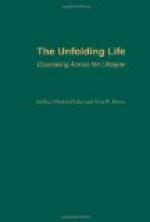The great law of teaching is here involved, that interest in and knowledge of the unknown can come only through interest in and knowledge of something which is like it. Paul says in Romans, “For the invisible things of Him since the world began are clearly seen, being perceived through the things that are made, even His everlasting power and divinity.” Therefore the first definite religious instruction which the child receives, must be upon spiritual truths illustrated in his own known world of interests.
IMITATION
The result of the efforts of curiosity, senses and activity is a constantly increasing store of ideas in the child’s mind, relating to these things in which he is interested. As these ideas enter his mind, applying this term to the “intellectual function of the soul,” he immediately wants to act upon them, according to a law inborn that an idea always tends to go out into action, unless it is held back. Adults have fixed habits of expressing ideas that come to them, but not so the child. An interesting activity is always a suggestion to him to reproduce it exactly, if possible. This difference between habit and suggestion in action is illustrated in the case of a long-suffering kitten in the hands of a resourceful child. The sight will arouse in another child an irresistible impulse to try the same experiment, while it always leads his mother to attempt a rescue.
This tendency to exact reproduction of activity is the instinct of imitation, and is a marked characteristic of childhood. As these words are written, a glance through the window discloses surveyors at work with tape and red chalk. Following in their wake is a five year old with diminutive string and piece of red crayon, laying out distances and taking measurements, in exact copy of his predecessors, a genuine “pocket edition” of the original.
While such elaborate exactness characterizes imitation in this period of childhood alone, the impulse to conform is never entirely lost. The desire grows more complex and general as the years go on, and from reproduction of definite acts, the life tries to emulate the spirit and achievements of its hero, and later to be in some harmony, at least, with public opinion. Brave, indeed, is the soul that dares to be a nonconformist in regard to the standards “they” have established.
The results of imitation are profoundly important in character building.
1. When a child re-enacts what he sees, he comes to a better understanding of its meaning. This is one purpose of the imitation of common activities in Kindergarten games.
2. The idea which is acted upon becomes an inseparable part of the life.
3. Habit is the outcome of repeated imitation.
4. Life grows like what it imitates.
With these facts in view, the application to the work of nurture is too obvious for discussion.




